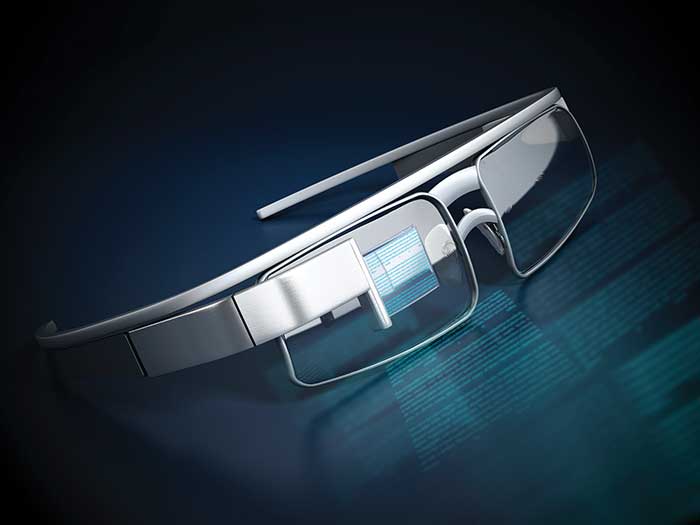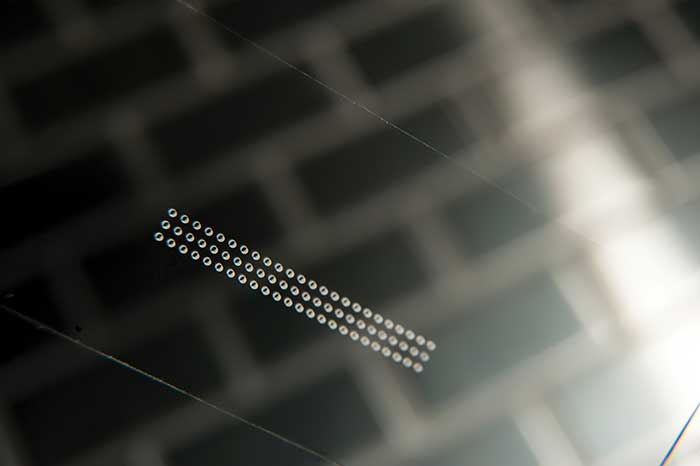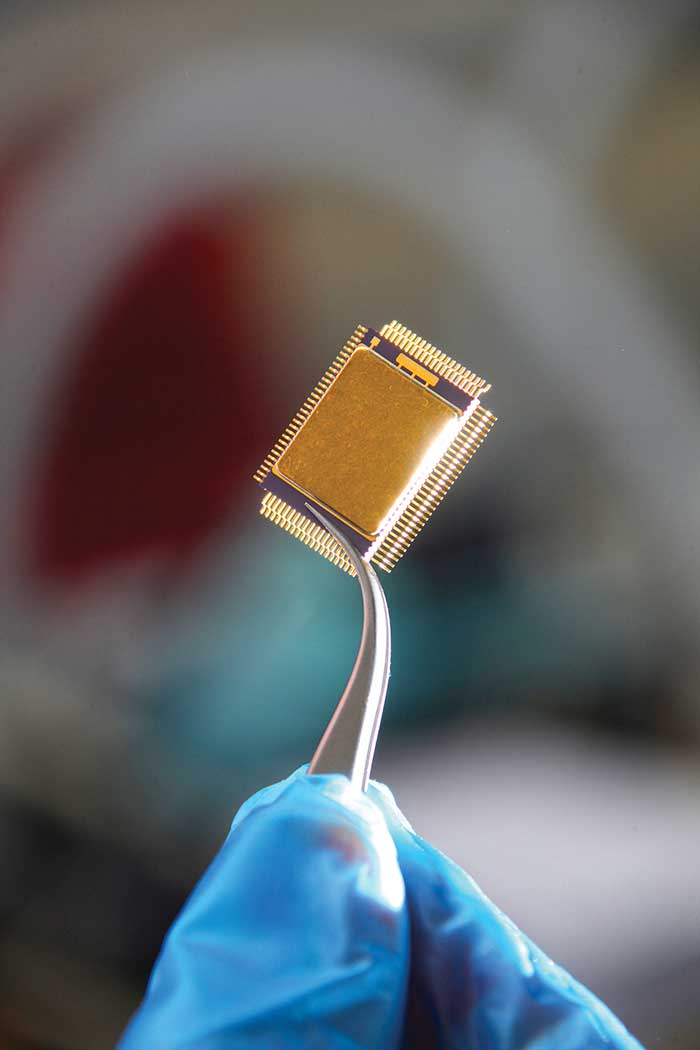AUSTIN HUANG, ELECTRO SCIENTIFIC INDUSTRIES INC.
Wearable technology has come a long way since the first smart watches and fitness trackers were introduced. Flexible printed circuitry and smaller components enable more powerful features and services in compact designs. Smart fabrics, leather and glass add aesthetic qualities, but fragile materials also increase risks for defects caused by production.
UV lasers are playing an important role in strengthening the production of wearables. From applying distinctive finishes to assembling small components, UV lasers can process a wider range of materials at ultrafast speeds. Fast-evolving laser production techniques for cutting, drilling and marking enable micron-scale precision and accuracy. Tighter, laser-based production controls allow manufacturers to compete in the race to bring new wearables products to market.

Manufacturers must achieve better precision to meet IP code ratings set forth by the International Electrochemical Commission that govern degree of protection against moisture and foreign solid objects. Courtesy of iStock.com/mikkelwilliam.
Experts forecast that sales for wrist-worn wearables will triple in 2018. With advanced wireless connectivity and massive computing power, modern wearables promise to redefine services industries. Augmented and virtual reality, as well as embedded software combined with 5G modems and sensors, will deliver multisensory experiences and distribute data in useful new ways.
The body-worn device market is expected to grow by $100 million over the next five years as new applications emerge for body cameras and smart glasses. As enterprise applications emerge, so do performance standards. The stakes grow higher as manufacturers must meet OEM’s more rigorous “minimum defect” policies. Meeting these requirements takes a new level of control and precision to sustain high yields and fast throughput that laser technology can help meet.
Systems-on-a-chip smaller than the width of a human finger control an array of immersive features on wearables devices. Capacitive touch interfaces are replacing mechanical buttons on watches, which bring down production costs but drive up complexity. With a user interface dependent on computer graphics, the glass surface display must withstand constant interaction. Better laser-glass processing methods are evolving that prevent cracking and breakage while producing a smooth and exact bezel fit.

Head-worn wearables must include batteries and storage for displaying high-quality video playback. Courtesy of iStock.com/adventtr.
Wearables are engineered to protect circuitry from moisture, but there is risk for damaging sensitive parts as they are assembled. The repeated contact of mechanical processing puts stress on small components and thin film resistors. A laser applies no pressure, and the beam can be focused at micron size for working with parts too small for mechanical tools to process.
Technical advantages
UV fiber lasers generate light by means of a single laser amplified by diodes. Light emitted through fiber optic cable is up to 100 times more intense than a CO2 laser. The fiber straightens the light and focuses it through a lens to produce a beam. Fiber lasers can bend or coil, making them more compact.
The advantage of fiber as a “gain medium” is that it takes less energy to excite and move the light to the focusing element because light is already in the fiber. By comparison, CO2 lasers consume various gasses to excite photons in a tube, which takes longer to heat and cool. Because fiber lasers don’t use focusing mirrors, the strength of a direct beam is more powerful.
At peak power, a UV laser can dispatch thousands of pulses strong enough to cut thin sheets of aluminum or steel. But on fabrics, prolonged exposure to laser light will burn materials. Adjusting the pulse speed and intensity of a UV laser enables fast, clean cutting without charring. With the flexibility to work with the broadest range of materials, UV lasers offer unlimited manufacturing combinations and options.

Temperature variance at the work surface can create thermal stress levels that result in glass breakage. A UV laser set for fast repitition and high intensity can make glass pliable, yet sustains a small heat-affected zone. Courtesy of iStock.com/LisaStrachan.
The ultraviolet spectrum disrupts the molecular bonds of materials without adding excess heat. A UV laser puts out sustained and high-quality optical energy. At shorter pulse lengths, the intense focused beam makes glass pliable at low heat. This enables new options for glass processing that can be adapted to produce more durable and water-resistant designs.
Efficient production
Preserving the highest possible yields and profits in high-variation/low-volume production comes down to efficiency. Ultrafast laser processing affords precise controls and the flexibility to adapt production methods for a wider variety of parts and materials.
A UV laser at high peak power can cut thick metals. With increased pulse repetitions at lower power, a laser can be programmed to process more brittle materials. For either application, UV lasers sustain high kilowatt output for extended periods to accelerate production. Staying calibrated for up to three months or longer, a laser can go 25,000 hours before requiring service. With fewer parts to maintain and replace, a UV laser is economical to operate.
Thermal management is an important consideration for wearables manufacturing since compact packaging of wearables increases the risk for damage to heat-affected zones. Designers and manufacturers test out many types of materials to select the best cooling properties. To achieve the best balance and energy transfers, they often pair hybrid materials such as polymers and low-conductive metals.
The use of UV lasers takes the process one step further. Through pulse speed and beam shaping manufacturing, technologists can better control heat-affected zones. At the same time, advanced software controls enable parallel laser manufacturing sequences for processing materials that share similar qualities. Reducing production steps reduces the risk of damage and speeds up throughput.
UV lasers also are making an important contribution in the compositing of smart fabrics and other hybrid material structures that enable innovative use of polymers and alloys in flexible, stretchable circuits.

Chip-scale packages and components that power wearables can be damaged by mechanical stress incurred during production. Laser micromachining applies no pressure while making precise contact where processing is needed. Courtesy of Electro Scientific Industries.
Designers and manufacturers must account for ease of assembly, repair
and end-of-life when developing production requirements. UV lasers
composite materials through welding or engraving that might otherwise
require post-processing work with glues or custom treatments. UV lasers
also can apply finishing touches, such as custom markings and patterns
to leather or aluminum, at higher quality and faster throughput than any
other method.
Laser micromachining is becoming a requisite for improving quality and yields and for reducing labor costs. Manufacturers with deep laser application experience for processing many types of materials will be better positioned to profit and be first to market with the next wave of wearables innovations.
Metrology vision systems and software combined with laser micromachining magnifies small parts as they are processed to achieve higher quality standards. By employing pattern matching techniques and CAD comparisons, metrology systems provide insights to detect problems and adjust production as needed. With the ability to detect errors, manufacturers can perform quality checks in flight and eliminate routine manual inspections that slow production times.
Facilitating new designs
Wearable devices undergo rigorous usability testing. Once the functionality is set, manufacturers evaluate various components and materials for compatibility, durability and functionality. Using baseline tolerances for material interaction, manufacturers can assess how materials react under extreme conditions. Manufacturing technologists use these insights to create material interaction recipes. The capability to cut and weld custom shapes with lasers ensures accurate samples and shortens development time.
Manufacturers also must find ways to deliver rapid design iterations while keeping costs low. How a material reacts in a lab can be different under actual production conditions. Environmental factors such as vibration and power supply affect laser cutting accuracy. To address this problem, industrial lasers feature stabilizers and power management controls to compensate for high-volume manufacturing.
Ergonomic wearables designs feature contours that require higher cutting accuracy than straight edges. Lasers integrated with advanced CCD imaging technology follow exact curves. The charge-coupled device detects electric signals from the laser’s cutting edge to focus the beam on a point that guides the cutting edge on the intended path.
Before manufacturers can begin assembly, technicians must remove tight groupings of components from large panels. Stress caused by mechanical cutting can damage sensitive electronics resulting in low yield and slower throughput. UV lasers can cut most substrate materials and follow contours with micron-level accuracy to remove components without incurring damage.
How to optimize performance
Over time, dust buildup from cutting and drilling begins to affect beam delivery, reducing cutting accuracy. It’s critical to remove particles and keep the optics clean as both dust and heat can damage product quality and the laser itself.
Some UV lasers designed for high-volume production use vacuum controls to remove debris while the machine operates. Encasing optics in a protective layer also helps to preserve sensitive parts. Without this, optics parts wear out with alarming frequency, resulting in substantial and necessary repair costs.
Laser systems are evolving as fast as the devices they produce, as new processing applications are refined for emerging use cases. One adaptation in laser micromachining is a two-dimensional stage that advances parts through the laser workflow. Moveable stages can perform precise manufacturing sequences, such as step and repeat operations. These advances are driving down operating costs so even second-tier manufacturers can afford to innovate with lasers.
Early laser tools became obsolete before the machine wore out. But modern lasers are modular so machines can be upgraded with more powerful laser optics as new product requirements drive capabilities upgrades. By upgrading the software and components inside the machine, manufacturers can minimize downtime that would be incurred by replacing the entire machine.
Despite slow consumer adoption of the smart watch, the wearables industry is expected to be worth $6 billion by 2021. There will be opportunities for manufacturers who have the technology and capabilities to transform complex materials into viable products. Manufacturers with deep laser application experience for processing many types of materials will be better positioned to profit and be first to market with the next wave of wearables innovations.
Meet the author
Austin Huang is a director of product marketing and business development at Electro Scientific Industries Inc. He holds a Ph.D., M.S. and B.S. in electrical engineering from the University of Texas at Austin and an M.S. in optical science from the University of Arizona; email: [email protected].